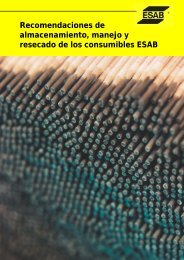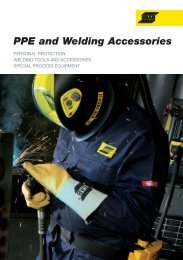Create successful ePaper yourself
Turn your PDF publications into a flip-book with our unique Google optimized e-Paper software.
circumferential welds on vacuum chamber<br />
helium vessel<br />
Figure 1. Sketch of the housing of a superconducting<br />
magnet, indicating circumferential joints on the helium<br />
vessel and the outer vacuum chamber. Longitudinal<br />
welds are part of the prefabricated subassembly which is<br />
plasma welded according to SMT welding specifications.<br />
Figure 2. Superconducting magnet coil to be contained<br />
in the helium vessel.<br />
vacuum chamber<br />
circumferential weld on helium vessel<br />
Figure 3. Motoman robot equipped with the Aristo TM<br />
robot package and internal clamp/manipulator.<br />
patient<br />
aperture<br />
narrow, due to the requirement of a perfect<br />
magnetic field in the middle of the scanner.<br />
Robot stations<br />
Apart from a substantial amount of manual TIG<br />
welding on smaller parts, including tacking of the<br />
major parts, the important circumferential joints are<br />
welded by robotic MIG welding – three or four per<br />
vessel, depending on the magnet type (Figure 1).<br />
For these welds, SMT uses two robot stations with<br />
Motoman UP50 6-axis robots on 2-axis<br />
manipulators. Both robots are equipped with the<br />
ESAB Aristo TM robot package consisting of an<br />
Aristo TM 500 water-cooled inverter power source, a<br />
robot mounted Robofeed 30-4 encapsulated wire<br />
feeder, cable assembly and torch and the U8<br />
control unit (Figure 3). Communication with the<br />
programming software of the robot is through<br />
Device Net. The robot head is equipped with a<br />
laser sensor for joint tracking and a camera to<br />
monitor the welding process on a screen.<br />
The first robot to be equipped with the Aristo TM<br />
process package was installed by a UK robot<br />
integrator, Bauromat, about 12 months ago, when<br />
SMT started manufacturing a new product. The 2nd<br />
was a retrofit of an older robot, about 6 months ago.<br />
Weld requirements and welding<br />
The number one requirement for the welds – on<br />
the helium vessel and the outer vacuum chamber<br />
– is absolute leak tightness. Helium is the second<br />
lightest gas known and a “very searching” element<br />
that can escape through the most microscopic of<br />
apertures, thereby determining the lifecycle of the<br />
complete magnet. One complication of this kind of<br />
closed construction, are the limited possibilities to<br />
perform NDT on the welds. The method applied by<br />
SMT is 100% penetrant testing of all welds, the<br />
reason being that any unseen defects will only<br />
become apparent at final testing, when the magnet<br />
is filled with helium and brought under vacuum,<br />
and can only be repaired at tremendous costs.<br />
A stable MIG welding process and a consistent<br />
and repeatable weld quality are therefore<br />
paramount. These are provided by carefully<br />
designed and tested welding procedures for the<br />
various joints, in combination with the digital programming<br />
and arc control features of the Aristo TM<br />
robot package. Parameter settings for each layer<br />
are stored at memory positions in the U8 control<br />
box, using the standard synergic lines with some<br />
slight adjustments. During the start-up phase of<br />
each product, a coupon plate was tested for each<br />
of the first 50 vessels requiring 100% success.<br />
Now confidence, backed-up by experience, is so<br />
great that only with every 50th magnet a coupon<br />
plate is welded, X-rayed and mechanically tested.<br />
As an example, the circumferential joint closing the<br />
helium vessel is a 60-70° V-preparation in 4mm to<br />
8mm thick stainless steel welded onto a stainless<br />
backing strip. It is welded in two layers – a root<br />
pass and a capping pass (Figure 5). The torch is in<br />
a fixed position – slightly over 12 o’ clock – while<br />
the magnet is rotated counter clockwise by a<br />
manipulator arm on the robot station (Figure 3).<br />
The filler material is an 1.2mm diameter 308LSi<br />
solid wire. The Si-type, in combination with the<br />
shielding gas, is chosen to obtain flat welds with a<br />
perfect wetting onto the plate edges. The shielding<br />
gas is an Ar/He/O 2<br />
mixture, where both the He and<br />
the O 2<br />
promotes flatter welds and improves<br />
wetting. The finishing touch is given, making use of<br />
the SuperPulse facility in the U8 control unit.<br />
SMT uses Pulse-Pulse for the root run – a high<br />
current pulse gives the required penetration, while<br />
a pulse at a lower current avoids overfilling of the<br />
joint. Altogether it gives an excellent weld pool<br />
control and the required security in terms of<br />
penetration. The capping run is done with<br />
traditional pulse with a weaving action.<br />
User-friendly equipment does the job<br />
SMT is very pleased with the performance of the<br />
Aristo TM process package in general and the userfriendliness<br />
of the U8 control box in particular,<br />
according to Malcolm Faithfull, Process Welding<br />
Engineer: “Our production is an environment where<br />
consistent quality is the number one requirement. In<br />
that sense it very much resembles the aerospace<br />
industry. Everything is produced to very narrow<br />
tolerances. The functionality of the Aristo robot<br />
equipment enables us to have complete control<br />
over the welding process and obtain a consistent<br />
weld result. All you need is there in terms of welding<br />
intelligence and all very easily accessible. The whole<br />
set-up of the control unit is designed to give you the<br />
shortest route to an optimum arc condition”.<br />
30 - <strong>Svetsaren</strong> no. 1 - <strong>2007</strong>




